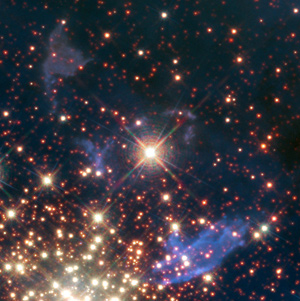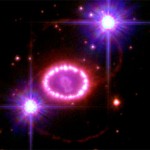Hubble is the gift that keeps on giving. Check this jaw-dropping stunner:
Holy wow! Click to embiggen, or go here to get a ginormous image.
This is an image of NGC 3603, a vast cloud of gas and dust that is cranking out stars like no one’s business. It’s one of the busiest stellar nurseries in our entire galaxy. That cluster of stars in the center has thousands of newly-born stars in it, including one named NGC 3603A. This bruiser is the most massive star ever to have its mass directly measured: it is a whopping 116 times heftier than the Sun. That’s about as massive as a star can get without tearing itself apart!
 But look to the upper right; see that bright star centered in some blue-ish gas? I’ve zoomed in on it here. That star is Sher 25, a massive B1a supergiant that is a ticking time bomb. Sometime in the next 20,000 years – and that’s a guarantee – it’ll blow, creating a supernova that will rival Venus for brightness! I know this because the gas around it is a classic hourglass-shaped bipolar nebula, created as the star itself expels dense winds of its own material. We’ve seen this before: around the supernova SN 1987a.
But look to the upper right; see that bright star centered in some blue-ish gas? I’ve zoomed in on it here. That star is Sher 25, a massive B1a supergiant that is a ticking time bomb. Sometime in the next 20,000 years – and that’s a guarantee – it’ll blow, creating a supernova that will rival Venus for brightness! I know this because the gas around it is a classic hourglass-shaped bipolar nebula, created as the star itself expels dense winds of its own material. We’ve seen this before: around the supernova SN 1987a.
 Here’s a shot from Hubble of 87a (click to embiggen this, too). You can see the ring around the star, and the faint rings around it top and bottom. It’s still not clear exactly how they formed, but it’s clear they’re from when the star was younger. The rings around 87a can be dated to be about 20,000 years old – that means the star made the rings and blew up 20,000 years later. Sher 25 already has rings, and it’s a bit hotter and more massive than the star that blew up in 1987… so it has no more than 20,000 years, and probably less, before it detonates as a tremendous supernova. I’ll note it’s 20,000 light years away, so it’s no danger to Earth.
Here’s a shot from Hubble of 87a (click to embiggen this, too). You can see the ring around the star, and the faint rings around it top and bottom. It’s still not clear exactly how they formed, but it’s clear they’re from when the star was younger. The rings around 87a can be dated to be about 20,000 years old – that means the star made the rings and blew up 20,000 years later. Sher 25 already has rings, and it’s a bit hotter and more massive than the star that blew up in 1987… so it has no more than 20,000 years, and probably less, before it detonates as a tremendous supernova. I’ll note it’s 20,000 light years away, so it’s no danger to Earth.
NGC 3603 is one of my favorite objects in the whole sky. I studied SN87a for my PhD, and a few years back I was a referee on a paper about Sher 25 – the only paper I ever professionally refereed. All for the best, I’m thinking.
Still, the nebulosity, the stars, Sher 25 – altogether, this is an amazing object, and a magnificent picture. We may even have an early entry for my annual Top Ten Astronomy Pictures of 2010.
Oh – this image was taken by my old grad advisor, Bob O’Connell. So now I think this object and I have come – pardon the expression – full circle.
Image credit: NASA, ESA, R. O’Connell (University of Virginia), F. Paresce (National Institute for Astrophysics, Bologna, Italy), E. Young (Universities Space Research Association/Ames Research Center), the WFC3 Science Oversight Committee, and the Hubble Heritage Team (STScI/AURA)
Related posts:
- Does this cluster make my mass look fat?
- Another Hubble stunner… and it’s a repeat. Kinda.
- Astronomers find the most massive star ever discovered
- 20 years ago today
- What is the next star that will explode? (a YouTube video I made)